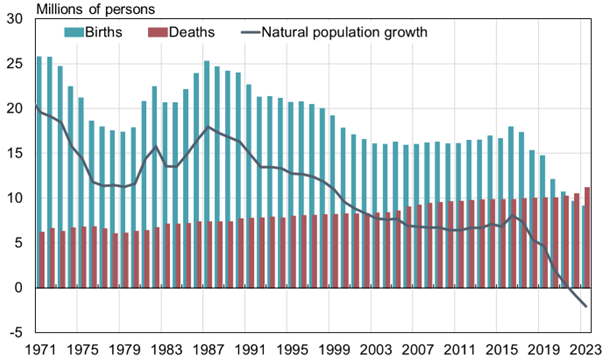BOFIT Viikkokatsaus / BOFIT Weekly Review 2024/06
The NBS reports that the country’s population declined in 2023 for the second consecutive year to 1.41 billion and that the average age of Chinese continues to rise rapidly. The working-age cohort (16–59-year-olds) shrank by 11 million to 865 million (61 % of the population). The number of persons over 60 increased by 17 million to 297 million. The number of persons under 16 fell by 8 million to 248 million.
China experienced a record-low 9 million births last year. Around the turn of the millennium, about twice the number of children were born annually compared to now, even if the “one child” policy was still in effect. China’s birth rate has plunged since 2020, falling last year to 6.39 births per 1,000 people. The fertility rate, i.e. the average number of children a woman gives birth to in her lifetime, fell close to 1 (1.09 in 2022), and well below the stable replacement rate of 2.1. At the same time, the mortality rate has been rising, with 11 million deaths recorded last year. Some of this may represent excess deaths caused by the Covid-19 pandemic, which experienced a strong wave in China in the first quarter of 2023 after the country abandoned its zero-covid policies in December 2022. It is unclear how the official population statistics account for excess mortality due to covid. According to official figures, China has suffered fewer than 84,000 covid deaths since August 2022. Some international attempts to measure the impacts from the rapid lifting of covid restrictions suggest the number may be closer to two million.
China’s urbanisation accelerated last year from 2022, but is well off the pace of five years ago. China’s urban population increased by 12 million last year to 933 million (66 % of the population). The number of rural residents fell by 14 million to 477 million. With the lifting of covid restrictions, the number of internal migrant labourers increased last year by 2 million to 298 million (covid lockdowns forced some migrant workers to move back to their villages). The demographic data released by the NBS does not take into account for immigration or emigration, but both figures are small and only have a marginal impact on population size. UN population figures show that net immigration to China has persistently been negative, i.e. more people leave China than immigrate. The UN estimates that net outward migration reduces the Chinese population by about 300,000 people a year.
The latest estimate from the Economist Intelligence Unit sees China’s population falling by 20 million by 2035. In the low fertility scenario of the latest UN population projection, China’s population shrinks even more, by about 50 million by 2035, which would put China’s population at about 1.36 billion. Last year’s realised population trend was, in fact, close to the UN’s low fertility rate scenario.
The government would also like to reorient the economy to better serve the needs of its ageing population. China’s government in January released guidelines to support a “silver economy.” The announced guidelines, however, are quite vague and include of such initiatives as better quality eldercare, “smart healthcare,” as well as stimulation of senior spending by offering products and services catering for their needs. Increasing the participation of older people in the labour force, however, was not mentioned. The government announced in 2022 that it would start to gradually increase the current retirement ages of 60 for men and 50 or 55 for women in the future. The schedule has yet to be announced. Government media reports that the silver economy already accounts for 6 % of China’s total economic activity and is expected to grow to 10 % by 2035. Chinese people tend to spend their final years at home. Only 3 % of elderly Chinese live in assisted care facilities.
Deaths now outnumber births in China
Sources: China National Bureau of Statistics, CEIC and BOFIT.